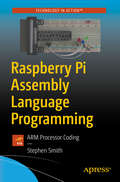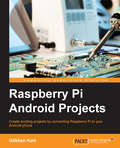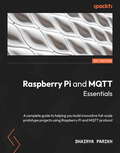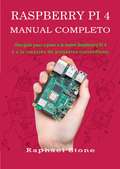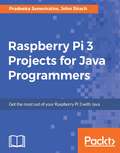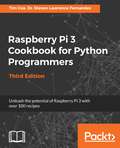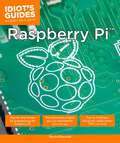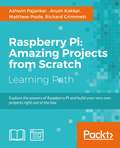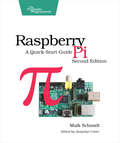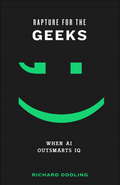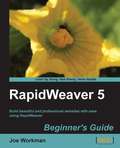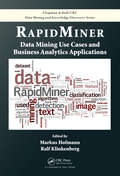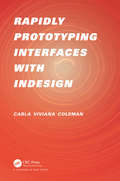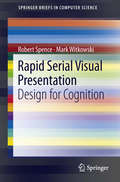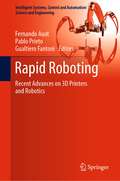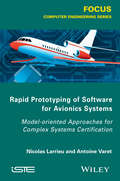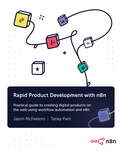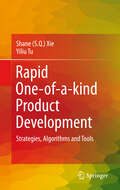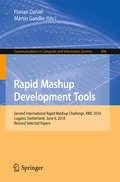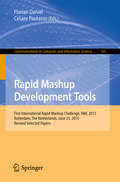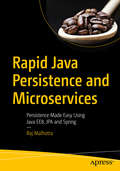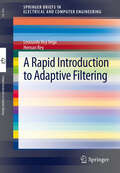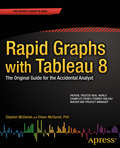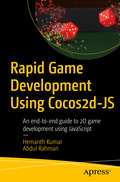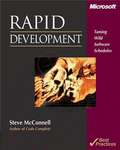- Table View
- List View
Raspberry Pi Assembly Language Programming: ARM Processor Coding
by Stephen SmithGain all the skills required to dive into the fundamentals of the Raspberry Pi hardware architecture and how data is stored in the Pi’s memory. This book provides you with working starting points for your own projects while you develop a working knowledge of Assembly language programming on the Raspberry Pi. You'll learn how to interface to the Pi’s hardware including accessing the GPIO ports. The book will cover the basics of code optimization as well as how to inter-operate with C and Python code, so you'll develop enough background to use the official ARM reference documentation for further projects. With Raspberry Pi Assembly Language Programming as your guide you'll study how to read and reverse engineer machine code and then then apply those new skills to study code examples and take control of your Pi’s hardware and software both.What You'll LearnProgram basic ARM 32-Bit Assembly LanguageInterface with the various hardware devices on the Raspberry PiComprehend code containing Assembly languageUse the official ARM reference documentationWho This Book Is ForCoders who have already learned to program in a higher-level language like Python, Java, C#, or C and now wish to learn Assembly programming.
Raspberry Pi Android Projects
by Gokhan KurtCreate exciting projects by connecting the Raspberry Pi to your Android phone About This Book * Manage most of the fundamental functions of Raspberry Pi from your Android phone * Use the projects created in this book to develop even more exciting projects in the future * A project-based learning experience to help you discover amazing ways to combine the power of Android and Raspberry Pi Who This Book Is For The target audience for this book includes Raspberry Pi enthusiasts, hobbyists, and anyone who wants to create engaging projects with Android OS. Some knowledge of Android programming would be helpful. What You Will Learn * Install the tools required on your Pi and Android to manage and administer the Pi from Android * Share your files between different Android devices using the Pi as a server * Set up the Pi to live-stream the camera in surveillance mode and customize Android to receive this content * Turn your Pi into a media center and control it from your Android * See your Android display on a large screen using Raspberry Pi * Connect your car's dashboard to your Android device using Raspberry Pi In Detail Raspberry Pi is the credit card-sized, general purpose computer which has revolutionized portable technology. Android is an operating system that widely used in mobile phones today both on the high and low ends of the mobile phone market. However, there is little information about how to connect the two in spite of how popular both of them are. Raspberry Pi Android Projects starts with simple projects that help you access the command prompt and the desktop environment of Raspberry Pi from the comfort of your Android phone or tablet. Then, you will be introduced to more complex projects that combine the strengths of the Pi and Android in amazing ways. These projects will teach you how to manage services on the Pi from Android, share files between Android devices using the Pi as a server, administer and view the Pi's camera from Android in surveillance mode, and connect your car to the Pi and make data more accessible using Android. The introductory projects covered will be useful each time you need to access or administer your Pi for other purposes, and the more advanced projects will continue to be valuable even after you become an expert on Pi. By the end of this book, you will be able to create engaging and useful projects that will help you combine the powers of both Android and Raspberry Pi. Style and approach A quick and easy-to-follow guide that will show how you can add up the power of Pi and Android by combining them.
Raspberry Pi and MQTT Essentials: A complete guide to helping you build innovative full-scale prototype projects using Raspberry Pi and MQTT protocol
by Dhairya ParikhGet familiar with all the concepts related to Raspberry Pi and MQTT, build innovative IoT projects, and discover how to scale these projects to the next levelKey FeaturesLearn some of the most popular tools used in IoT – Raspberry Pi, MQTT, ESP8266 and moreBuild exciting projects such as an IoT weather station and a smart switch boardDiscover the advantages of taking your MQTT broker globalBook DescriptionThe future of IoT has the potential to be limitless. Wouldn't it be great if you could add it to your own technological stacks? But where to start? With the basics, of course. In this book, you will start by learning about the most popular hardware and communication protocol, Raspberry Pi and MQTT. You will see how to use them together by setting up your own MQTT server on Raspberry Pi and understand how it works. This book explores MQTT in detail, including the clients and devices that you can connect to your server. You will discover two very popular IoT development boards among project developers: the ESP8266 and ESP32 development boards. Then, you will learn how to build interactive dashboards on your Pi and monitor your client devices. The book also shows you how to build a dashboard using another popular software – Node-RED. You will be able to put your skills to the test by creating two full-scale projects. That's not all: you will also learn how to host your own MQTT server on a virtual cloud service. Finally, you will be guided on how to move forward from here, what technologies to learn, and some project recommendations to polish or test your knowledge. By the end of this book, you will be able to build meaningful projects using Raspberry Pi and MQTT and create dashboards for your projects on Node-RED.What you will learnConfigure and use a Raspberry Pi for IoT projectsImplement the MQTT communication protocol for projectsUnderstand how to set up the NodeMCU and ESP32 boards as MQTT clientsControl a NodeMCU board through a Node-RED dashboard hosted on Raspberry PiGet LAMP server, Home Assistant, and MariaDB on the Raspberry PiSet up an online MQTT broker on a cloud service or enterprise service provider platformBuild full-scale, end-to-end prototype projectsWho this book is forThis book is for students who are interested in IoT and want to build projects using the available developer hardware. Educators who want to introduce a course on IoT into their curriculum, technology enthusiasts, and IoT developers who are just getting started will also benefit from this book. No prior knowledge about the two main topics that the book covers is required - Raspberry Pi and MQTT. A basic understanding of what IoT is will also be useful but not mandatory.
Raspberry Pi 4 Manual Completo: Una guía paso a paso a la nueva Raspberry Pi 4 y a la creación de proyectos innovadores.
by Raphael StoneFelicitaciones por convertirte en un explorador de la Raspberry Pi 4. Estamos seguros de que disfrutarás descubrir un mundo de la informática completamente nuevo y la posibilidad de crear tus propios juegos, controlar tus propios robots y máquinas, y compartir tus experiencias con otros fanáticos de la Raspberry Pi. La Raspberry Pi 4 puede hacer una cantidad sorprendente de cosas. Los entusiastas de la tecnología aficionados utilizan las placas Pi como centros de medios, servidores de archivos, consolas de juegos retro, enrutadores y bloqueadores de anuncios a nivel de red, sólo por mencionar algunos. Sin embargo, eso es solo una muestra de lo que es posible. Hay cientos de proyectos por ahí, donde la gente ha utilizado a la Pi para construir tabletas, computadoras portátiles, teléfonos, robots, espejos inteligentes, tomar fotografías en el espacio exterior, o para realizar experimentos en la Estación Espacial Internacional. Con la Pi 4 siendo más rápida, capaz de decodificar video 4K, beneficiándose de un almacenamiento más rápido a través de USB 3.0 y conexiones de red más rápidas a través de Ethernet de un Gigabit, la puerta está abierta a muchos usos nuevos. También es la primer Pi que admite dos pantallas, hasta dos pantallas 4K@30, una bendición para los creativos que desean más espacio en el escritorio. No tienes que ser un científico espacial para comenzar a desarrollar tus propios proyectos; El MANUAL COMPLETO DE RASPBERRY PI 4 está aquí para revolucionar la forma en que percibes la informática de una vez por todas. Aquí hay un resumen de lo que aprenderás: • Configuración de tu Raspberry Pi 4 • Cómo instalar software • Instalación de Windows 10 en Raspberry Pi 4 • Comandos Raspberry Pi • Cómo construir robots • Cómo hacer juegos • Instalación de paquetes • Crear y ejecutar un script de Shell �
Raspberry Pi 3 Projects for Java Programmers
by Pradeeka Seneviratne John SirachLearn the art of building enticing projects by unleashing the potential of Raspberry Pi 3 using Java About This Book • Explore the small yet powerful mini computer in order to run java applications • Leverage Java libraries to build exciting projects on home automation, IoT, and Robotics by leveraging Java libraries • Get acquainted with connecting electronic sensors to your Raspberry Pi 3 using Java APIs. Who This Book Is For The book is aimed at Java programmers who are eager to get their hands-on Raspberry Pi and build interesting projects using java. They have a very basic knowledge of Raspberry Pi. What You Will Learn • Use presence detection using the integrated bluetooth chip • Automatic light switch using presence detection • Use a centralized IoT service to publish data using RPC • Control a robot by driving motors using PWM • Create a small web service capable of performing actions on the Raspberry Pi and supply readings • Image capture using Java together with the OpenCV framework In Detail Raspberry Pi is a small, low cost and yet very powerful development platform. It is used to interact with attached electronics by the use of it's GPIO pins for multiple use cases, mainly Home Automation and Robotics. Our book is a project-based guide that will show you how to utilize the Raspberry Pi's GPIO with Java and how you can leverage this utilization with your knowledge of Java. You will start with installing and setting up the necessary hardware to create a seamless development platform. You will then straightaway start by building a project that will utilize light for presence detection. Next, you will program the application, capable of handling real time data using MQTT and utilize RPC to publish data to adafruit.io. Further, you will build a wireless robot on top of the zuma chassis with the Raspberry Pi as the main controller. Lastly, you will end the book with advanced projects that will help you to create a multi-purpose IoT controller along with building a security camera that will perform image capture and recognize faces with the help of notifications. By the end of the book, you will be able to build your own real world usable projects not limited to Home Automation, IoT and/or Robotics utilizing logic, user and web interfaces. Style and approach The book will contain projects that ensure a java programmer gets started with building interesting projects using the small yet powerful Raspberry Pi 3. We will start with brushing up your Raspberry Pi skills followed by building 5-6 projects
Raspberry Pi 3 Cookbook for Python Programmers: Unleash the potential of Raspberry Pi 3 with over 100 recipes, 3rd Edition
by Dr Steven FernandesA recipe-based guide to programming your Raspberry Pi 3 using PythonKey FeaturesLeverage the power of Raspberry Pi 3 using Python programmingCreate 3D games, build neural network modules, and interface with your own circuitsPacked with clear, step-by-step recipes to walk you through the capabilities of Raspberry PiBook DescriptionRaspberry Pi 3 Cookbook for Python Programmers – Third Edition begins by guiding you through setting up Raspberry Pi 3, performing tasks using Python 3.6, and introducing the first steps to interface with electronics. As you work through each chapter, you will build your skills and apply them as you progress. You will learn how to build text classifiers, predict sentiments in words, develop applications using the popular Tkinter library, and create games by controlling graphics on your screen. You will harness the power of a built in graphics processor using Pi3D to generate your own high-quality 3D graphics and environments.You will understand how to connect Raspberry Pi’s hardware pins directly to control electronics, from switching on LEDs and responding to push buttons to driving motors and servos. Get to grips with monitoring sensors to gather real-life data, using it to control other devices, and viewing the results over the internet. You will apply what you have learned by creating your own Pi-Rover or Pi-Hexipod robots. You will also learn about sentiment analysis, face recognition techniques, and building neural network modules for optical character recognition.Finally, you will learn to build movie recommendations system on Raspberry Pi 3.What you will learnLearn to set up and run Raspberry Pi 3Build text classifiers and perform automation using PythonPredict sentiments in words and create games and graphicsDetect edges and contours in imagesBuild human face detection and recognition systemUse Python to drive hardwareSense and display real-world dataBuild a neural network module for optical character recognitionBuild movie recommendations systemWho this book is forThis book is for anyone who wants to master the skills of Python programming using Raspberry Pi 3. Prior knowledge of Python will be an added advantage.
Raspberry Pi (Idiot's Guides)
by Thorin KlosowskiThe Raspberry Pi is an inexpensive, simple computer that's about the size of a credit card. It has multiple inputs and outputs that make it the foundation for almost a limitless number of projects — from creating a wi-fi hot spot to an elaborate, programmed LED light show. Idiot's Guides: Raspberry Pi is the perfect beginner book for learning how it works, how to program it (using Scratch, a basic program for programming Linux), how to connect it to an existing device, and how to put together some basic first projects.
Raspberry Pi: Making Amazing Projects Right from Scratch!
by Ashwin Pajankar Richard Grimmett Arush Kakkar Matthew PooleExplore the powers of Raspberry Pi and build your very own projects right out of the box About This Book * From robotics to gaming, this Learning Path will unlock your creativity! * Build your own impressive IoT projects to transform your home * Featuring some of Packt's very best Raspberry Pi content, this Learning Path doesn't just get you to your destination - it opens up a whole horizon of possibilities! Who This Book Is For Want new ideas for your next Raspberry Pi project? Got one lying around gathering dust? This Learning Path gets you straight into the creative dirty work of programming and playing with your pi. Whether your new to Raspberry Pi, or an experienced maker, we think this Learning Path will inspire you and get your creative juices flowing! What You Will Learn * Discover an aweome range of Raspberry Pi projects * Bridge the gap between software and hardware through your Pi and find out how to make an operating system interact with cameras and other hardware * Find out how to use your Raspberry Pi for gaming * Secure your home with this tiny computer! * Make science fiction a reality - build a walking robot In Detail Looking for inspiration for your next Raspberry Pi project? Not sure where to begin? This Learning Path is the perfect place to begin, providing you with an accessible yet comprehensive journey through Raspberry Pi. Following three modules, you'll soon be confident and prepared to get creative with your microcomputer. Raspberry Pi by Example is the first module in this Learning Path - and it does exactly what it says. It doesn't just teach, it shows you how to go and build some awesome Raspberry Pi projects immediately. Build and play your own games with the Pi, build a complete Internet of Things home automation system that controls your house through Twitter... let your imagination run wild! In the next module we'll look in more depth at building a home security system. You'll be using some of the skills you devoped through the first module, but apply them to something more intricate and impressive. Using a Linux based operating system as the foundations, you'll gradually build up an entire security infrastructure adding cameras, remote controls, and even intrusion alerts! In the final module, we'll take you into the world of Raspberry Pi robotics. By the end of it, you'll have built a biped robot that can interact with its environment! This Learning Path combines some of the best that Packt has to offer in one complete, curated package. It includes content from the following Packt products: * Raspberry Pi By Example by Ashwin Pajankar and Arush Kakkar * Building a Home Security System with Raspberry Pi by Matthew Pole * Raspberry Pi Robotics Essentials by Richard Grimmett Style and approach It's not every day you build a home automation system. It's not every day you build a walking robot. But with this Learning Path you'll do just that. So get started and let this tiny computer expand your imagination.
Raspberry Pi: A Quick-Start Guide
by Maik SchmidtPrinted in full color.Most of the book is targeted at beginners in computing and programming. A few parts, such as the small electronics project and setting up a web server, assume some intermediate skills.The Raspberry Pi is one of the most successful open source hardware projects ever. For less than $40, you get a full-blown PC, a multimedia center, and a web server--and this book gives you everything you need to get started. You'll learn the basics, progress to controlling the Pi, and then build your own electronics projects. This new edition is revised and updated with two new chapters on adding digital and analog sensors, and creating videos and a burglar alarm with the Pi camera. Get your Raspberry Pi up and running and doing cool stuff. You'll start with the basics: adding hardware, installing and configuring Debian Linux, and customizing the Pi's firmware to get the most out of your hardware.Then the fun begins. You'll connect the Pi to your home network, surf the web, and tweet messages. You'll learn how to get the most out of Midori, the Pi's standard browser, and control the desktops of other PCs with the Pi. Then you'll explore the Pi's versatility with a series of home projects. Turn it into a web server in your home network; convert the Pi into a powerful multimedia center so you can watch high-definition video and listen to your favorite music; and play classic video games.Then you'll use the GPIO pins on the Raspberry Pi to build your own electronics projects, such as an "out of memory" alarm. You'll learn how to use digital and analog sensors with the Pi, even though the Pi doesn't have analog input ports! Finally, you'll set up the Pi camera, create your own time-lapse videos, and build an automatic e-mailing burglar alarm. Power to the Pi!What You NeedYou need a Raspberry Pi and several things that you probably already have at home, such as a keyboard, a mouse, a monitor/TV set, and an SD card. To build the electronic projects you need a few cheap parts and the Pi camera.
Rapture for the Geeks: When AI Outsmarts IQ
by Richard DoolingWill the Geeks inherit the earth? If computers become twice as fast and twice as capable every two years, how long is it before they're as intelligent as humans? More intelligent? And then in two more years, twice as intelligent? How long before you won't be able to tell if you are texting a person or an especially ingenious chatterbot program designed to simulate intelligent human conversation? According to Richard Dooling in Rapture for the Geeks--maybe not that long. It took humans millions of years to develop opposable thumbs (which we now use to build computers), but computers go from megabytes to gigabytes in five years; from the invention of the PC to the Internet in less than fifteen. At the accelerating rate of technological development, AI should surpass IQ in the next seven to thirty-seven years (depending on who you ask). We are sluggish biological sorcerers, but we've managed to create whiz-bang machines that are evolving much faster than we are. In this fascinating, entertaining, and illuminating book, Dooling looks at what some of the greatest minds have to say about our role in a future in which technology rapidly leaves us in the dust. As Dooling writes, comparing human evolution to technological evolution is "worse than apples and oranges: It's appliances versus orangutans. " Is the era of Singularity, when machines outthink humans, almost upon us? Will we be enslaved by our supercomputer overlords, as many a sci-fi writer has wondered? Or will humans live lives of leisure with computers doing all the heavy lifting? With antic wit, fearless prescience, and common sense, Dooling provocatively examines nothing less than what it means to be human in what he playfully calls the age of b. s. (before Singularity)--and what life will be like when we are no longer alone with Mother Nature at Darwin's card table. Are computers thinking and feeling if they can mimic human speech and emotions? Does processing capability equal consciousness? What happens to our quaint beliefs about God when we're all worshipping technology? What if the human compulsion to create ever more capable machines ultimately leads to our own extinction? Will human ingenuity and faith ultimately prevail over our technological obsessions? Dooling hopes so, and his cautionary glimpses into the future are the best medicine to restore our humanity.
RapidWeaver 5 Beginner's Guide
by Joe WorkmanThis book is a step-by-step tutorial that includes all the project files and complete source code for all of the webpages created. Each tutorial has concise steps that will allow you to walk through them easily. Most tutorials will have an optional exercise for the more advanced users to take things to the next level. If you are a novice wanting to build your first website or an experienced user looking for a better way to develop your existing websites, then this book is for you. This book is perfect for iWeb users that are looking for something better. It's also great for advanced users who use applications like Dreamweaver and are looking for a simpler way to develop websites without sacrificing the ability to get into the code. Using this book, you can build entire websites without writing a single line of code. But if you know a little web programming then you will be able to take your websites to the next level.
RapidMiner: Data Mining Use Cases and Business Analytics Applications (Chapman And Hall/crc Data Mining And Knowledge Discovery Ser. #33)
by Markus HofmannPowerful, Flexible Tools for a Data-Driven WorldAs the data deluge continues in today's world, the need to master data mining, predictive analytics, and business analytics has never been greater. These techniques and tools provide unprecedented insights into data, enabling better decision making and forecasting, and ultimately the solution of incre
Rapidly Prototyping Interfaces with InDesign
by Carla Viviana ColemanRapidly Prototyping Interfaces with InDesign guides readers to learn to create a wide range of interfaces, from mobile to desktop. With InDesign, interface prototyping takes minutes instead of days. This book is code-free and entirely hands-on with InDesign tools. This book acts as a guide for how to prototype user interfaces with InDesign, using diagrams, illustrations, and screen shots. This illustrated book concerns the creation and prototyping of eBooks, eMagazines, websites, desktop apps and movile apps. InDesign is an important tool for rapid prototyping, as no coding is involved. <P><P>Key Features <li>No available book provides this information. <li>The reader will learn how to prototype a wide range of interfaces for both desktop and movile platforms. <li>The book will include software screen shots and guide the reader step by step. <li>The example prototypes will be interactive. Users can test them using interactive devices, such as desktop computers, tablets or mobile phones. <li>The reader will learn how to prepare an effective portfolio and resume.
Rapid Serial Visual Presentation
by Robert Spence Mark WitkowskiA powerful new image presentation technique has evolved over the last twenty years, and its value demonstrated through its support of many and varied common tasks. Conceptually, Rapid Serial Visual Presentation (RSVP) is basically simple, exemplified in the physical world by the rapid riffling of the pages of a book in order to locate a known image. Advances in computation and graphics processing allow RSVP to be applied flexibly and effectively to a huge variety of common tasks such as window shopping, video fast-forward and rewind, TV channel selection and product browsing. At its heart is a remarkable feature of the human visual processing system known as pre-attentive processing, one which supports the recognition of a known image within as little as one hundred milliseconds and without conscious cognitive effort. Knowledge of pre-attentive processing, together with extensive empirical evidence concerning RSVP, has allowed the authors to provide useful guidance to interaction designers wishing to explore the relevance of RSVP to an application, guidance which is supported by a variety of illustrative examples.
Rapid Roboting: Recent Advances on 3D Printers and Robotics (Intelligent Systems, Control and Automation: Science and Engineering #82)
by Fernando Auat Pablo Prieto Gualtiero FantoniThis book summarizes recent advances in robotics using 3D printers and rapid prototyping as a concept development tool. The book is focused on industrial applications, educational aspects, rehabilitation, and other related topics. In particular, the book is intended to offer the reader a smooth yet deep introduction to the use of 3D printers and rapid prototyping techniques as a solution to robotics and mechatronics problems, highlighting successful case studies.
Rapid Prototyping Software for Avionics Systems
by Antoine Varet Nicolas LarrieuThe design, implementation and validation of avionics and aeronautical systems have become extremely complex tasks due to the increase of functionalities that are deployed in current avionics systems and the need to be able certify them before putting them into production. This book proposes a methodology to enable the rapid prototyping of such a system by considering from the start the certification aspects of the solution produced. This method takes advantage of the model-based design approaches as well as the use of formal methods for the validation of these systems. Furthermore, the use of automatic software code generation tools using models makes it possible to reduce the development phase as well as the final solution testing. This book presents, firstly, an overview of the model-based design approaches such as those used in the field of aeronautical software engineering. Secondly, an original methodology that is perfectly adapted to the field of aeronautical embedded systems is introduced. Finally, the authors illustrate the use of this method using a case study for the design, implementation and testing of a new generation aeronautical router.
Rapid Product Development with n8n: Practical guide to creating digital products on the web using workflow automation and n8n
by Jason McFeetors Tanay PantLearn n8n to reduce costs, improve efficiency, and increase productivity in your development processKey FeaturesDiscover best practices, advantages, and case studies from the n8n teamExplore practical techniques to build market-ready low-code solutions using n8n and BubbleLearn how to develop enterprise-scale web applications without any engineering supportBook DescriptionExplore how n8n enables you to connect different systems and cloud services without having to hire specialists or develop technical skill sets across multiple tech stacks. This book will show you how n8n can reduce the time required to develop new products, helping you bring them to the market quickly compared to building a whole development team.This official n8n guide will assist you with adopting and integrating n8n in your development workflow in the best possible manner. You'll begin by learning where n8n fits in the tech stack of your business and how it provides opportunities for reducing cost as well as increasing efficiency and revenue. Once you've identified opportunities where you can leverage n8n's connectivity and automation functionality within your working environment, you'll progress to building an n8n-based toolset that will increase the profitability of your operations.By the end of this product development book, you'll be able to identify real-world opportunities to generate income, improve efficiencies, and then build tools to capitalize on these opportunities.What you will learnIdentify opportunities to use n8n in your organization and develop a business use caseUnderstand how to use APIs and webhooks with n8nBuild a custom production-ready API endpoint for your n8n applicationsCreate an end-to-end web application by connecting an API to the frontendAutomate your digital processes based on time and external triggersDevelop complex business applications rapidly using a low-code approachWho this book is forThis book is for web developers and low code enthusiasts who have basic knowledge of JavaScript as well as some basic understanding of web concepts such as APIs and webhooks. Developers looking for a digital platform to enable rapid prototyping and automation for their workflow will find this book useful.
Rapid One-of-a-kind Product Development
by Yiliu Tu Shane Shengquan XieRapid One-of-a-kind Product Development discusses research in the development of new enabling technologies for small and medium companies. Scientific advancements presented include a novel product data modelling scheme to model product design, manufacturability and knowledge under a common data object; customised product development in a distributed environment; and new adaptive scheduling methods for the optimal production of a wide variety of customised products, taking into consideration all of the possible changes from customers and the uncertainties in manufacturing. The book also includes research towards a computer aided customer interface, which allows customer requirements and changes to be processed and integrated with technical designs in real time; adaptive and concurrent CAD methods and algorithms; and product modelling and system integration technologies. The reader will learn how to: * translate customer requirements to technical attributes; * develop new and innovative products to meet customer requirements and expectations; * evaluate and optimise a project design; * design production systems and use them efficiently; and * manage a variety of customised products. Rapid One-of-a-kind Product Development demonstrates how to develop new methods, tools and algorithms to address the problems in a mass customisation environment. It is a valuable source of information for researchers and engineers in the fields of design and manufacturing.
Rapid Mashup Development Tools
by Florian Daniel Martin GaedkeThis book constitutes revised selected papers from the Second International Rapid Mashup Challenge, RMC 2016, held in Lugano, Switzerland in June 2016. The 6 papers presented in this volume were carefully reviewed and selected from 8 submissions. They are post-challenge extensions of the selected short participation proposals. The 2016 edition of the Challenge is the second installment of a series of challenges that aim to engage researchers and practitioners in a competition for the best mashup approach.
Rapid Mashup Development Tools
by Florian Daniel Cesare PautassoThis book constitutes the refereed proceedings of theFirst International Rapid Mashup Challenge, RMC 2015, held on June 23, 2015, inRotterdam, The Netherlands, in conjunction with the 15th International Conferenceon Web Engineering, ICWE 2015. The 2015 edition of the challenge is the firstinstallment of a series of challenges that aim to engage researchers andpractitioners in a competition for the best mashup approach. The 6 thoroughlyreviewed contributions contained in this volume are extended versions of theinitial proposals that served the authors to express their interest toparticipate in the challenge. The initial proposals have been used by thechallenge organizers to select participants based on the interestingness andmaturity of the proposals.
Rapid Java Persistence and Microservices: Persistence Made Easy Using Java EE8, JPA and Spring
by Raj MalhotraGain all the essentials you need to create scalable microservices, which will help you solve real challenges when deploying services into production. This book will take you through creating a scalable data layer with polygot persistence. You’ll cover data access and query patterns in Spring and JPA in high-performance environments. As part of this topic, you’ll see the advantages of multiple persistence frameworks in Java and especially the easy persistence offered by NoSQL databases and reactive web solutions. The last few chapters present advanced concepts that are useful for very high-performance real-time applications: you’ll implement applications using Spring’s good support for Web sockets in their raw form as well as for connecting to message brokers such as RabbitMQ. This can be useful for applications such as navigation systems and gaming platforms.What You Will LearnBuild end-to-end modern applications using microservices, persistence essentials, reactive web, and other high-performance concepts Master Spring’s configuration optionsSecure microservices efficiently Monitor your services post deployment Who This Book Is For Java developers and architects interested in microservices.
A Rapid Introduction to Adaptive Filtering (SpringerBriefs in Electrical and Computer Engineering)
by Hernan Rey Leonardo Rey VegaIn this book, the authors provide insights into the basics of adaptive filtering, which are particularly useful for students taking their first steps into this field. They start by studying the problem of minimum mean-square-error filtering, i.e., Wiener filtering. Then, they analyze iterative methods for solving the optimization problem, e.g., the Method of Steepest Descent. By proposing stochastic approximations, several basic adaptive algorithms are derived, including Least Mean Squares (LMS), Normalized Least Mean Squares (NLMS) and Sign-error algorithms. The authors provide a general framework to study the stability and steady-state performance of these algorithms. The affine Projection Algorithm (APA) which provides faster convergence at the expense of computational complexity (although fast implementations can be used) is also presented. In addition, the Least Squares (LS) method and its recursive version (RLS), including fast implementations are discussed. The book closes with the discussion of several topics of interest in the adaptive filtering field.
Rapid Graphs with Tableau 8: The Original Guide for the Accidental Analyst
by Stephen McDaniel Eileen McDanielTired of boring spreadsheets and data overload from confusing graphs? Master the art of visualization with Rapid Graphs with Tableau 8! Tableau insiders Stephen and Eileen McDaniel expertly provide a hands-on case study approach and more than 225 illustrations that will teach you how to quickly explore and understand your data to make informed decisions in a wide variety of real-world situations. Rapid Graphs with Tableau 8 includes best practices of visual analytics for ideas on how to communicate your findings with audience-friendly graphs, tables and maps."A picture is worth a thousand words" is a common saying that is more relevant today than ever as data volumes grow and the need for easy access to answers becomes more critical. This book covers the core of Tableau capabilities in easy-to-follow examples, updated and expanded for Version 8. Learn how to be successful with Tableau from the team that started the original training program as the founding Tableau Education Partner! "A must read for anyone interested in Tableau. Clear explanations, practical advice and beautiful examples!"Elissa Fink – Chief Marketing Officer, Tableau Software
Rapid Game Development Using Cocos2d-JS
by Hemanth Kumar Abdul RahmanGet a gentle introduction to the Cocos2d-JS framework to begin working with sprite manipulations, animations, and other 2d game development topics. This book covers environment setup and getting started with a framework that works seamlessly across all browsers. Rapid Game Development Using Cocos2d-JS teaches you the overall architecture of Cocos2d-JS and explains the internal working of the framework. You will dive deep into sprites, the most important entity in Cocos2d-JS, animation APIs, and primitive shapes. You'll also learn about the Cocos2d-JS UI system to get a head start in 2d game development. Finally, you'll discover the features of Chipmunk (the built-in physics engine) with full examples. What You'll Learn Get a simple head start in Cocos2d-JS Gain an architectural overview of the different blocks of the framework Master sprites, spritesheets, and frame animation Work with the event system in Cocos2d-JS Discover the animation APIs in Cocos2d-JS Leverage the built-in physics engine Who This Book Is For Beginners looking to develop cross-platform mobile/web games with cocos2d-js, developers with intermediate skills on cocos2d-js looking for the reference.
Rapid Development
by Steve McconnellCorporate and commercial software-development teams all want solutions for one important problem--how to get their high-pressure development schedules under control. In RAPID DEVELOPMENT, author Steve McConnell addresses that concern head-on with overall strategies, specific best practices, and valuable tips that help shrink and control development schedules and keep projects moving. Inside, you'll find: A rapid-development strategy that can be applied to any project and the best practices to make that strategy work Candid discussions of great and not-so-great rapid-development practices--estimation, prototyping, forced overtime, motivation, teamwork, rapid-development languages, risk management, and many othersA list of classic mistakes to avoid for rapid-development projects, including creeping requirements, shortchanged quality, and silver-bullet syndromeCase studies that vividly illustrate what can go wrong, what can go right, and how to tell which direction your project is goingRAPID DEVELOPMENT is the real-world guide to more efficient applications development.
